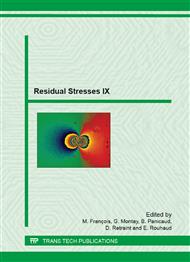[1]
T.N. Nguyen, M.A. Wahab, The effect of weld geometry and residual stresses on the fatigue of welded joints under combined loading, Journal of Materials Processing Technology, Volume 77, Issues 1–3, 1 May 1998, Pages 201-208.
DOI: 10.1016/s0924-0136(97)00418-4
Google Scholar
[2]
C.M. Sonsino, Effect of residual stresses on the fatigue behaviour of welded joints depending on loading conditions and weld geometry, International Journal of Fatigue, Volume 31, Issue 1, January 2009, Pages 88-101.
DOI: 10.1016/j.ijfatigue.2008.02.015
Google Scholar
[3]
L.L. Martinez, R.L. Peng, A.F. Blom, D.Q. Wang, Welding and tig-dressing induced residual stresses- relaxation and influence on fatigue strength of spectrum loaded weldments, In: G. Marquis and J. Solin, Editor(s), European Structural Integrity Society, Elsevier, 1999, Volume 23, Pages 117-133.
DOI: 10.1016/s1566-1369(99)80035-1
Google Scholar
[4]
X. Cheng, J.W. Fisher, H.J. Prask, T. Gnäupel-Herold, B.T. Yen, S. Roy, Residual stress modification by post-weld treatment and its beneficial effect on fatigue strength of welded structures, International Journal of Fatigue, Volume 25, Issues 9–11, September–November 2003, Pages 1259-1269.
DOI: 10.1016/j.ijfatigue.2003.08.020
Google Scholar
[5]
D. Tawfik, P.J. Mutton, W.K. Chiu, Experimental and numerical investigations: Alleviating tensile residual stresses in flash-butt welds by localised rapid post-weld heat treatment, Journal of Materials Processing Technology, Volume 196, Issues 1–3, 21 January 2008, Pages 279-291.
DOI: 10.1016/j.jmatprotec.2007.05.055
Google Scholar
[6]
M. Takanachi, K. Kamata, K. Iida, Relaxation des contraintes résiduelles de soudage par sollicitation en fatigue d'assemblages soudés bout à bout, Soudages et Techniques connexes, Juillet-Août (2001).
Google Scholar
[7]
M. Mochizuki, Control of welding residual stress for ensuring integrity against fatigue and stress-corrosion cracking, Nucl. Eng. Des. 237 (2) (2007), 107–123.
DOI: 10.1016/j.nucengdes.2006.05.006
Google Scholar
[8]
P. Ferro, H. Porzner, A. Tiziani, F. Bonollo, The influence of phase transformations on residual stresses induced by the welding process – 3D and 2D, numerical models, Model. Simul. Mater. Sci. Eng. 14 (2006) 117–136.
DOI: 10.1088/0965-0393/14/2/001
Google Scholar
[9]
J.B. Leblond and J.C. Devaux, A new kinetic model for anisothermal transformation metallurgical transformations in steel including effect of austenite grain size, Acta Metallurgica, 32, 1, pp.137-146, (1984).
DOI: 10.1016/0001-6160(84)90211-6
Google Scholar
[10]
J.B. Leblond and J.C. Devaux, Mathematical modelling of transformation plasticity in steels. I : Case of ideal plastic phases, International Journal of Plasticity, vol5, (1996).
DOI: 10.1016/0749-6419(89)90001-6
Google Scholar
[11]
J.B. Leblond and J.C. Devaux, Mathematical modelling of transformation plasticity in steels. II : Coupling with strain hardening phenomena, International Journal of Plasticity, vol5, (1996).
DOI: 10.1016/0749-6419(89)90002-8
Google Scholar
[12]
P. Tekriwal, J. Mazumder, Transient and residual thermal strain-stress analysis of GMAW, ASMEJ Eng. Mater. Technol. 113 (1991) 336–343.
DOI: 10.1115/1.2903415
Google Scholar


